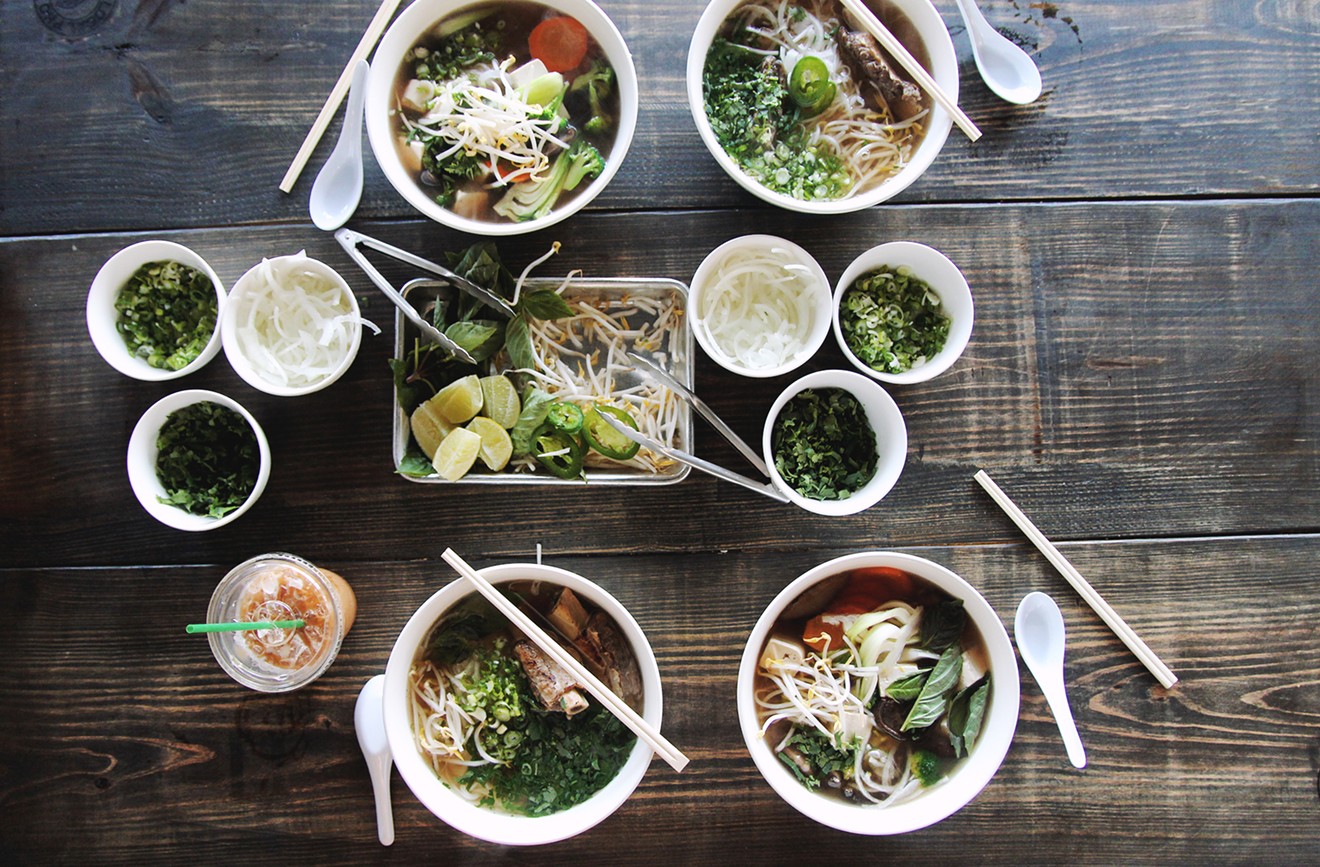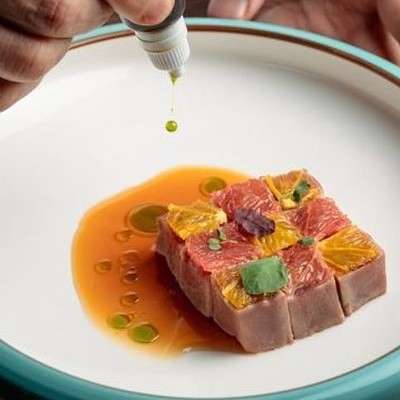A huge white root arcs off a metal tray filled with onions, ginger, a fat carrot, a tin of rehydrated shiitake mushrooms, and various herbs and spices: the building blocks for my semi-private lesson in pho-making.
“This is daikon,” says Tom Pham, co-owner and executive chef, pointing to the root. Today, the owners of the Heights-based Local Pho are teaching my friend Isabel and I how to make both the beef and vegetarian (vegan, in fact) pho broths. The mildly earthy daikon is one of the essential ingredients for the vegan broth.
He lets me chop the daikon and carrot and halve the onions as he starts up the heat on a huge pot with just a shimmer of oil lining the bottom—this is where we’ll briefly saute the shiitakes. Despite being surrounded by the industrial-sized pots, stoves and commercial equipment of the Local Pho kitchen, it almost feels like I’m learning how to make pho in a neighbor’s kitchen.

The building blocks of the vegetable pho broth: onions, ginger, carrot, daikon, green onion and cilantro stems, mushrooms and spices.
Photo by Erika Kwee
Comfort was, after all, the inspiration behind the new pho shop. Although neither of the co-owners (husband and wife team Linda and Tom Pham) had experience in the restaurant industry or cooking professionally, once they committed to opening a restaurant concept, it didn’t take long to select pho as the cornerstone of their establishment.
“Pho is our comfort food,” says Linda. “We wanted to keep the menu streamlined and simple, but we knew that we wanted to base it around pho.”
Tom had grown up watching his mother cook all his life, but it wasn’t until recent years that he actually tried his hand at making pho. Now, he’s the key mastermind behind Local Pho’s recipe and technique. While northern pho tends to be more herbal and southern pho more beef-forward, Local Pho serves up a kind of hybrid.
It’s also one one of the rare pho spots that makes its own vegetarian broth which, while admittedly not authentic, is nonetheless tasty. Added ingredients to the stock such as green onion and cilantro stems harken back to a time when the less wealthy might have thrown whatever they had into a pot of soup. At Local Pho, it’s also a way to reduce food waste, with the leafy tops used on banh mi or as pho toppings, the bottoms used to round out the flavors of their broth.
But first, the lesson starts with the true workhorses: the halved onions and ginger are placed on a grill to char for 5 minutes on each side, a crucial flavor-building step (for home cooks, broiling can work in place of grilling). The heat arching off the grill where searing onion halves drip juices onto the grates is so intense I fear for my phone when I take a fleeting overhead shot.
Meanwhile, once the shiitakes have seared, Tom adds two giant buckets of water. For this lesson, we’re making enough broth for about 12 bowls of pho. Once that comes to a light simmer and the onions have seared on both sides, he adds all the grilled vegetables to the broth, which is set aside to simmer for an hour.
Simmering, not boiling, is key to great pho broth. When I asked why, Tom shrugged. “I don’t know, it’s just something my mom always said,” he said. Internet research uncovered this insight: low and slow simmering is the only way to properly infuse the broth with bone marrow, which is an essential flavor. Even with vegetarian broth, boiling can distort the flavor.
Tom typically lets the vegan broth simmer for an hour at this point before adding the spices. In the meantime, Linda proffers Vietnamese coffee. We watch as she steeps each cup of coffee individually before pouring the coffee into a plastic cup lined with a scant half-inch or so of condensed milk.
“I don’t like the coffee too sweet—plus it’s fattening,” she explains. “I like when it tastes just a little bitter. Of course, we’ll make it sweeter if the customer asks, but people rarely do.”
The complex flavor of the coffee comes from a proprietary combination of four different coffee beans to get just the right flavor. Once the coffee is poured into the condensed milk, Linda inserts an immersion blender into the cup and blends until she achieves a smooth tawny shade with a frothy lid, explaining that the aeration and the foam enhance the flavor of the coffee. And once she adds ice and hands the finished cup to us, it really does taste exceptional: rich, just a little bitter, and just sweet enough.
Then it’s time for the spices.
“We start with cinnamon, cardamom and star anise,” says Tom, plucking the star-shaped seeds off a tray, leaving behind the bead-like fennel, clove and coriander seeds. These whole spices go into a pan to toast until fragrant. After adding the smaller spices for a quick toast, everything is tossed into a small mesh bag, which gets thrown into the broth pot.
At this point, it should be noted that the broth smells fantastic—rich and savory, yet slightly sweet from the spices. I marvel that we made such a complex-smelling broth with so few ingredients—a far cry from the tons of exotic ingredients I always imagined must be required for pho broth.
While we let the broth simmer, Tom moves to the industrial refrigerator, where he pulls out buckets of soaked knuckles and femur for the beef broth. Clear broth is prized in pho and is only achieved by a proper cleaning of the meat and bones—at Local Pho, the intensive cleaning process of the meat involves an overnight soak before boiling for few hours while skimming the impurities off the surface of the water. The meat and bones are then transferred to the broth pot where it simmers for around 18 hours before serving to achieve maximum flavor.
“Some days we sell out, some days we have broth left over, but we always toss leftovers and make fresh broth for the next day,” says Tom.
For the beef stock, the same basic steps are followed as for the vegetarian stock except that the mushrooms, carrot and daikon are omitted. They recently introduced a new riblet pho that has been well-received by customers so far—Tom boils the riblets before a brief torch for caramelization.

Riblets are torched for caramelization before being added to bowls of the new riblet pho.
Photo by Erika Kwee
“We tried out our pho recipe on a lot of family and friends in order to perfect it,” says Linda. “One comment that we heard frequently is that our pho doesn’t smell beefy, but it tastes beefy, which is important.”
The last step of the pho involves adding salt and rock sugar to achieve the perfect balance of salt and sweet. Once it comes time to serve pho for a customer, vegetables and a knot of dried noodles are quickly blanched for about 10 seconds before placing into a bowl destined for a ladling of fragrant broth.
“Knowing how to scoop the broth is important,” says Linda. “You have to know how to scoop the broth to avoid the fat that sits on the top. We have some customers who ask for extra fat, so we’ll scoop it differently for them, but for most customers, we scoop it so that it’s clear.”
Once the pho is brought to the table, we all sit down with a communal platter of fresh bean sprouts, sliced jalapeno, sprigs of Thai basil and chopped green onion, cilantro and white onion.
As for how to eat pho? Linda says it’s up to the individual—she likes to use her spoon to hold a dollop of hoisin sauce into which she dips bites of meat, eaten alongside bites of noodles. However, there are two universal tips she shared for eating pho. The first: eat it right away.
“The longer you let pho sit, the more the noodles will absorb the liquid and expand—too long, and they’ll get soggy,” Linda says. For to-go orders, they pack the noodles and broth separately expressly to avoid this issue. If you’re dining in, you should start mixing in your herbs and sauces in immediately for the optimal experience.
Second: always spoon the broth from the bottom up.
“When you let pho sit, all the good stuff will rise to the top so when you get to the bottom, the flavor is completely different,” says Linda. “You should constantly be mixing and scooping the broth from the bottom to get a balanced flavor.”
For additional flavor, they also stock a fiery, garlicky chili oil in tiny plastic containers that sets the vegan pho off brilliantly.
Our lesson left me wondering: is pho the perfect comfort food? Relatively healthy, relatively easy to make at home...whether you're making it at home or slurping it up at your local pho shop, there's never been a better time to add pho to your winter repertoire.















